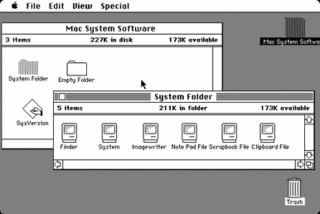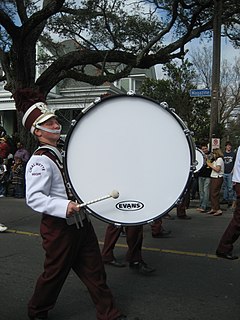Carbon is one of Apple’s C-based application programming interfaces (APIs) for Mac OS X, the operating system that powers Macintosh computers. Carbon provided a good degree of backward compatibility for programs that ran on Mac OS 8 and 9. Developers could use the Carbon APIs to port their “classic” Mac software to the Mac OS X platform with little effort, compared to porting the app to the entirely different Cocoa system, which originated in OPENSTEP.

The Macintosh Plus computer is the third model in the Macintosh line, introduced on January 16, 1986, two years after the original Macintosh and a little more than a year after the Macintosh 512K, with a price tag of US$2599. As an evolutionary improvement over the 512K, it shipped with 1 MB of RAM standard, expandable to 4 MB, and an external SCSI peripheral bus, among smaller improvements. It originally had the same generally beige-colored case as the original Macintosh, but in 1987, the case color was changed to the long-lived, warm gray "Platinum" color. It is the earliest Macintosh model able to run System 7 OS.

The Macintosh Classic is a personal computer designed, manufactured and sold by Apple Computer, Inc. from October 1990 to September 1992. It was the first Macintosh to sell for less than US$1,000.
The resource fork is a fork or section of a file on Apple's classic Mac OS operating system, which was also carried over to the modern macOS for compatibility, used to store structured data along with the unstructured data stored within the data fork.

The Finder is the default file manager and graphical user interface shell used on all Macintosh operating systems. Described in its "About" window as "The Macintosh Desktop Experience", it is responsible for the launching of other applications, and for the overall user management of files, disks, and network volumes. It was introduced with the first Macintosh computer, and also exists as part of GS/OS on the Apple IIGS. It had been rewritten completely with the release of Mac OS X in 2001.
The history of macOS, Apple's current Mac operating system originally named Mac OS X until 2012 and then OS X until 2016, began with the company's project to replace its "classic" Mac OS. That system, up to and including its final release Mac OS 9, was a direct descendant of the operating system Apple had used in its Macintosh computers since their introduction in 1984. However, the current macOS is a Unix operating system built on technology that had been developed at NeXT from the 1980s until Apple purchased the company in early 1997.

Mac OS 9 is the ninth major release of Apple's classic Mac OS operating system. Introduced on October 23, 1999, it was promoted by Apple as "The Best Internet Operating System Ever", highlighting Sherlock 2's Internet search capabilities, integration with Apple's free online services known as iTools and improved Open Transport networking. While Mac OS 9 lacks protected memory and full pre-emptive multitasking, lasting improvements include the introduction of an automated Software Update engine and support for multiple users.

System 7 is a graphical user interface-based operating system for Macintosh computers and is part of the classic Mac OS series of operating systems. It was introduced on May 13, 1991, by Apple Computer, Inc. It succeeded System 6, and was the main Macintosh operating system until it was succeeded by Mac OS 8 in 1997. Features added with the System 7 release included virtual memory, personal file sharing, QuickTime, QuickDraw 3D, and an improved user interface.

System 6 is a graphical user interface-based operating system for Macintosh computers. It was released in 1988 by Apple Computer, Inc. and is part of the classic Mac OS series of operating systems. System 6 was included with all new Macintosh computers until it was succeeded by System 7 in 1991. The boxed version of System 6 cost $49 when introduced. System 6 is classed as a monolithic operating system. It features an improved MultiFinder, which allows for co-operative multitasking.
Mac OS Roman is a character encoding primarily used by the classic Mac OS to represent text. It encodes 256 characters, the first 128 of which are identical to ASCII, with the remaining characters including mathematical symbols, diacritics, and additional punctuation marks. It is suitable for English and several other Western languages. Mac OS Roman is a superset of the original Macintosh character set, used in System 1.
The Macintosh Toolbox is a set of application programming interfaces with a particular access mechanism. They implement many of the high-level features of the Classic Mac OS. The Toolbox consists of a number of "managers," software components such as QuickDraw, responsible for drawing onscreen graphics, and the Menu Manager, which maintain data structures describing the menu bar. As the original Macintosh was designed without virtual memory or memory protection, it was important to classify code according to when it should be loaded into memory or kept on disk, and how it should be accessed. The Toolbox consists of subroutines essential enough to be permanently kept in memory and accessible by a two-byte machine instruction; however it excludes core "kernel" functionality such as memory management and the file system. Note that the Toolbox does not draw the menu onscreen: menus were designed to have a customizable appearance, so the drawing code was stored in a resource, which could be on a disk.
Rhapsody was the code name given to Apple Computer's next-generation operating system during the period of its development between Apple's purchase of NeXT in late 1996 and the announcement of Mac OS X in 1998. At first more than an operating system, Rhapsody represented a new strategy for Apple, who intended the operating system to run on x86-based PCs and DEC Alpha workstations as well as on PowerPC-based Macintosh hardware. In addition, the underlying API frameworks would be ported to run natively on Microsoft Windows NT. Eventually the non-Apple platforms were dropped and later versions consisted primarily of the OPENSTEP operating system ported to the Power Macintosh along with a new GUI to make it appear more Mac-like. Several existing "classic" Mac OS technologies were also ported to Rhapsody, including QuickTime and AppleSearch. Rhapsody could also run Mac OS 8 in a "Blue Box" emulation layer.
A menu bar is a graphical control element which contains drop-down menus.
Macintosh Manager started as a replacement for Apple Computer's At Ease workstation software. It originally ran on Mac OS 9 with AppleShare IP, and came with OS X Server up to version 10.3 Panther. In version 10.4 Tiger, Macintosh Manager was removed.

The Macintosh is a family of personal computers designed, manufactured, and sold by Apple Inc. since January 1984. The original Macintosh was the first mass-market personal computer that featured a graphical user interface, built-in screen and mouse. Apple sold the Macintosh alongside its popular Apple II family of computers for almost ten years before they were discontinued in 1993.

The family of Macintosh operating systems developed by Apple Inc. includes the graphical user interface-based operating systems it has designed for use with its Macintosh series of personal computers since 1984, as well as the related system software it once created for compatible third-party systems.
The classic Macintosh startup sequence included the startup chime, Happy Mac, Sad Mac, and Chimes of Death. These had all been done away with over time, and the release of the 2016 MacBook Pro eliminated the final remaining startup feature: the startup chime, in favor of a more discrete sequence with a black background and no audible indicators, despite its use as a security feature that provided a user-friendly, audible verification that a computer's NVRAM configuration is authentic. Apple added the startup chime back for the release of the 2017 MacBook Air.










